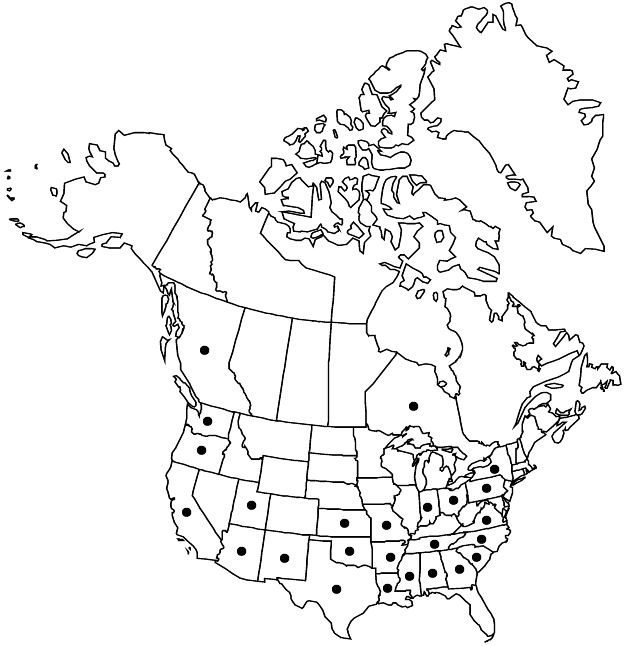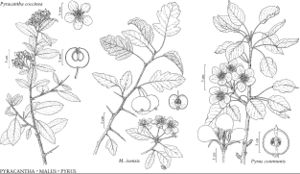Difference between revisions of "Pyracantha coccinea"
Fam. Nat. Syn. Monogr. 3: 219. 1847.
FNA>Volume Importer |
FNA>Volume Importer |
||
| Line 10: | Line 10: | ||
|special_status={{Treatment/ID/Special_status | |special_status={{Treatment/ID/Special_status | ||
|code=F | |code=F | ||
| − | |label= | + | |label=Illustrated |
}}{{Treatment/ID/Special_status | }}{{Treatment/ID/Special_status | ||
|code=I | |code=I | ||
| Line 18: | Line 18: | ||
|name=Mespilus pyracantha | |name=Mespilus pyracantha | ||
|authority=Linnaeus | |authority=Linnaeus | ||
| + | |rank=species | ||
|publication_title=Sp. Pl. | |publication_title=Sp. Pl. | ||
|publication_place=1: 478. 1753 | |publication_place=1: 478. 1753 | ||
| Line 45: | Line 46: | ||
-->{{#Taxon: | -->{{#Taxon: | ||
name=Pyracantha coccinea | name=Pyracantha coccinea | ||
| − | |||
|authority=M. Roemer | |authority=M. Roemer | ||
|rank=species | |rank=species | ||
| Line 60: | Line 60: | ||
|publication title=Fam. Nat. Syn. Monogr. | |publication title=Fam. Nat. Syn. Monogr. | ||
|publication year=1847 | |publication year=1847 | ||
| − | |special status= | + | |special status=Illustrated;Introduced |
| − | |source xml=https://jpend@bitbucket.org/aafc-mbb/fna-data-curation.git/src/ | + | |source xml=https://jpend@bitbucket.org/aafc-mbb/fna-data-curation.git/src/f50eec43f223ca0e34566be0b046453a0960e173/coarse_grained_fna_xml/V9/V9_793.xml |
|subfamily=Rosaceae subfam. Amygdaloideae | |subfamily=Rosaceae subfam. Amygdaloideae | ||
|tribe=Rosaceae tribe Gillenieae | |tribe=Rosaceae tribe Gillenieae | ||
Revision as of 22:44, 16 December 2019
Plants: crowns spreading, 10–60 dm. Stems: young twigs gray-hairy, glabrescent later. Leaves: stipules 4–8 mm; petiole 2–5 mm; blade elliptic or ovate to lanceolate or oblanceolate, 2–4 × 0.7–1.5 cm, base cuneate, margins finely crenulate-serrulate, apex acute, rarely obtuse, abaxial surface slightly hairy when young, glabrescent, adaxial glabrous. Inflorescences 3–4 cm diam.; bracteoles in distal axils 4–10 × 3–4 mm. Pedicels 3–10 mm, with coarse pale hairs. Flowers 6–8 mm diam.; hypanthium finely hairy; sepals triangular, 1.5–2 mm, apex acute; petals suborbiculate, 3–5 mm, apex rounded. Pomes bright red, 5–8 mm diam.; pedicels 5–12 mm. 2n = 34 (Europe).
Phenology: Flowering Mar–May; fruiting Aug–Jan.
Habitat: Mixed conifer forests, disturbed ground, fields, thickets, roadsides
Elevation: 0–1500 m
Distribution

B.C., Ont., Ala., Ariz., Ark., Calif., Ga., Ind., Kans., La., Miss., Mo., N.Mex., N.Y., N.C., Ohio, Okla., Oreg., Pa., S.C., Tenn., Tex., Utah, Va., Wash., s Europe, w Asia, introduced also in w Europe (England), e Asia (Japan), Africa (South Africa), Australia.
Discussion
Pyracantha coccinea has been extensively planted throughout most of temperate North America. The species is native from southern Europe east to the Caucasus and western Asia.
Selected References
None.
